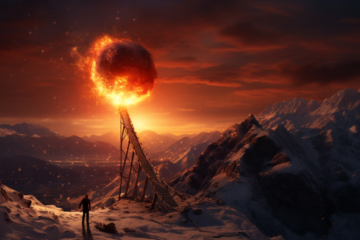The Gnome Sun takes place in a world full of magic – literally. Before the events that lead up to this adventure, the natural magical field of the world is what lights up the days. Daylight is something that just happens, without a distinct source, high across the sky. Imagine a bright summer day with no cloud in sight. Now remove the sun from that image but keep all the light.

Daylight in this setting will be slightly more diffuse, but wax and wane just like it would if it came from a celestial ball of fire. In theory, this adventure can fit into any world, as long as you are willing to mess with the canon daylight sources. And, of course, risk that your world is plunged into eternal darkness as a result.
This is part of The Gnome Sun, a Slow burn Sourcebook.
The Source of Daylight
There is no sun. So where does the light come from? In this world and setting, daylight is a by-product of the intrinsic magical field of the world. Imagine a sea of untapped potential. Natural sources replenish it over time, while magic users upon it to fuel their spells, but only minuscule amounts.
When more magic is created than is being used, the reservoir will shed the surplus energy as light emanating from the sky every day. For millennia, more magic was created than all the spellcasters combined could use up in a day. Thus daylight – the overflowing magic potential of the world – became a common occurrence. As a matter of fact, it happened every day, without fail.
The Beginning of the End
As is customary with progress, people invent new things to make their lives easier. In this particular case, a spell was discovered that turns magic into light. At first it was only used by explorers as a replacement for torches and lamps deep underground, but as mages became more practiced, they managed to permanently imbue objects with it.

Thus, they created magic lanterns that shed light that was indistinguishable from daylight. Because it was, in effect, the same mechanism that created it. Over time, though, more and more of these lanterns were used to light up the darkness. From the insides of homes during the hours of night to city streets in the twilight hours, the number of small spells that turned magic into light grew exponentially.
Downward Spiral
Nobody knew at the time that the daylight itself came from magic. From the surplus magic in the world. Which they were collectively draining through more and more additional sources of light. Eventually, people began to notice that the days appeared to grow shorter. Not by much at first, and most dismissed the idea as something of a slow seasonal change. Of course, more lamps were set up to remedy the lack of daytime.

You can see where this is going. Using up more magic made the daylight wane even further, and even when the relation between surplus magic in the world and daylight was being discovered, people kept adding to their repertoire of arcane light sources that were the root of the problem to begin with.
A Natural Solution
If this was allowed to continue unchecked, the world declines into darkness and cold. Days grow shorter and shorter as well as dimmer and dimmer. Eventually, the newly created magic energy seeps out through countless pinpricks, none of them producing enough light to be of any use, while not leaving arcane practitioners enough energy to cast anything remotely productive. Weather ceases to happen, plants wither, livestock soon follows. The world dies, and the lamps continue to exist forever, bleeding the magic dry each and every day.
If you are into a “multi world approach” where multiple “material planes” exist, such a world might be an interesting one to visit for your party. Maybe bend the rules in a way that they would still be able to cast some magic (as to not get them stranded there), or make it easy to undo the damage. Maybe someone was close to figuring things out, but failed to press a big red button in time.
Somebody should do Something
Of course there are some with an eye for change more keen than others. In this case, this role falls to a family of gnome alchemists. But that is a topic for another article.
For more, check out The Gnome Sun Slow Burn Sourcebook. Eventually, there will be a lot more. If there is not, why not subscribe to my newsletter?
